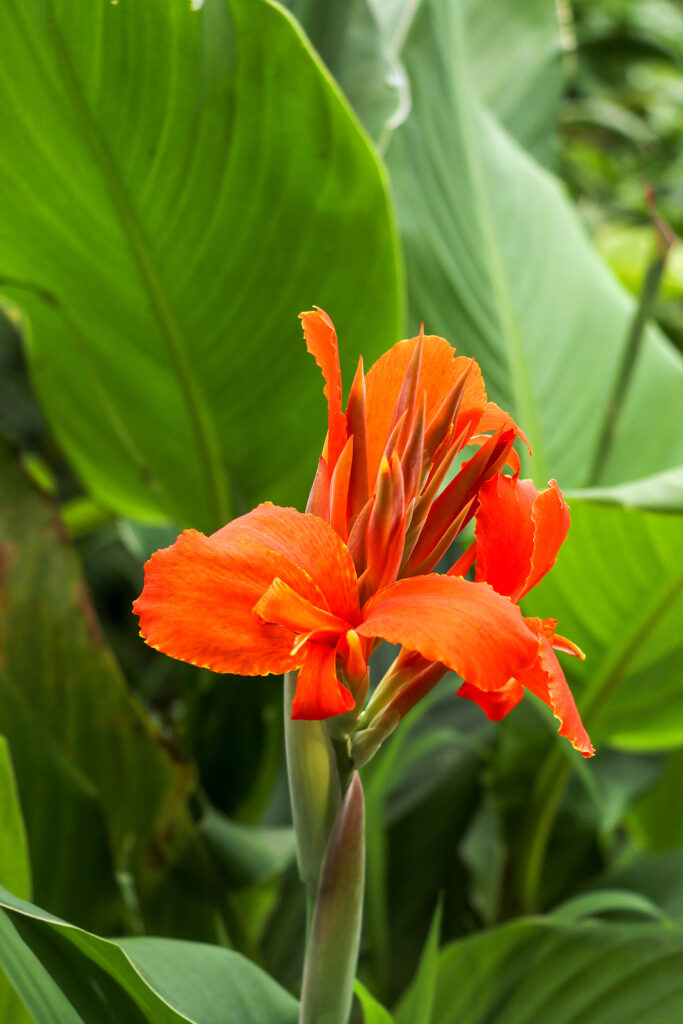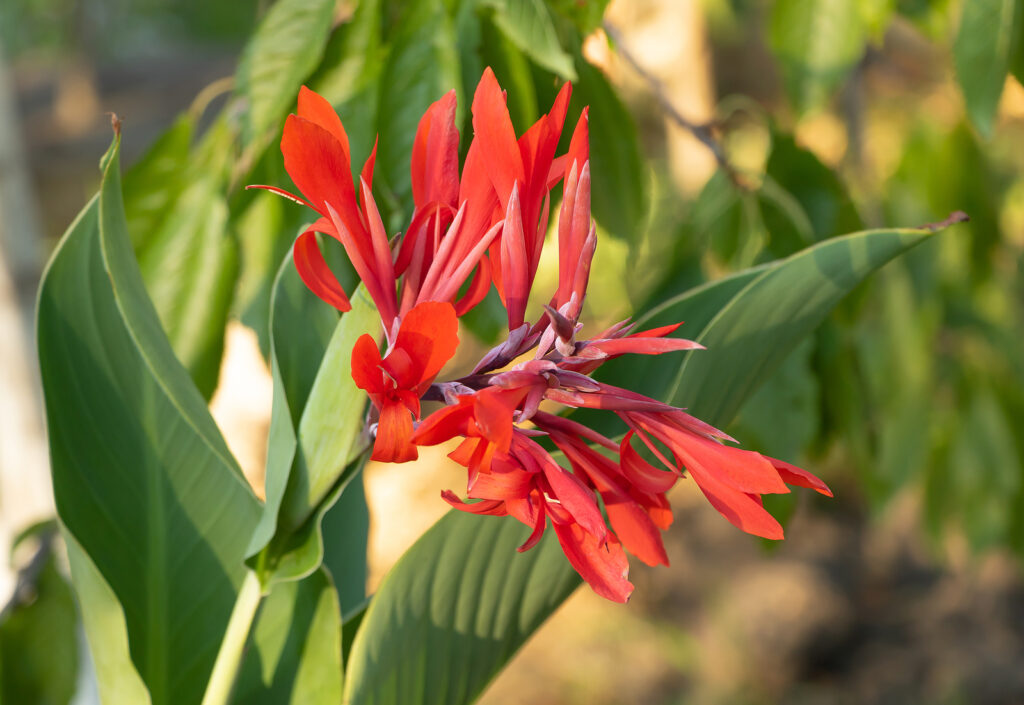Canna is an upright tropical perennial with large oval leaves and orchid-like flowers. Cannas can be grown in all regions, but they will be killed by frost if not protected or lifted and brought indoors.
Cannas are often grown for their decorative foliage as much as their colorful flowers. Foliage is sometimes green and yellow striped, sometimes solid green or purple. Canna flowers are tubular and flaring, commonly pink, red, orange, yellow, or white.
Cannas bloom from mid-summer to early fall. Shorter cultivars can be used in mixed borders or containers. Taller types are often used in island beds where they can be viewed from all angles.
Cannas grow from rhizomes; their spread can be aggressive if not monitored.

Get to know Canna
- Plant type: Tender summer-blooming bulb; annual in Zones 2-7; perennial in Zones 8-11.
- Growing Zones and range: 2-11, see above
- Hardiness: Tender; killed by hard frost but tolerant of high heat
- Height and width: 18 inches (45cm) to 8 feet (2.4m) tall; 10 to 24 inches (25-61cm) or more wide
- Foliage: Large leaves with markings of greens, yellows, whites, and purples.
- Flowers: Showy, plumes of tubular, flaring flowers with several petals held above ornamental foliage; flowers are red, pink, cream, peach, yellow, orange, sometimes spotted or streaked.
- Bloom time: Spring until frost
- Uses: Plant in mass or in beds and borders
- Botanical name: Canna hybrids
- Common name: Canna, Canna lily
Where to plant Canna
- Grow canna in full sun.
- Canna tolerates a variety of soils but grows best in humus-rich, well-drained soil.
- Canna prefers a soil pH of 6 to 8.

When to plant Canna
- Plant canna in the garden in spring after the soil has warmed, a week or two after the last frost.
- Work ample aged compost into the soil at planting time.
- Start seeds anytime indoors; start seed outdoors after all danger of frost has passed.
- Set rhizomes or plants outdoors when the weather is warm and all danger of frost has passed.
Planting and spacing Canna
- Before sowing seeds, nick the pea-like seed coat and soak the seed in water overnight. Sow seeds in six-packs or flat filled with sterile seed starting mix.
- Cover seeds 1/2 inch deep and keep them at 70°F (21°C) or above until seeds germinate in several weeks.
- Grow seedlings in bright light or under fluorescent light.
- Harden off plants before setting them in the garden after all danger of frost has passed.
- Sow seeds outdoors after all danger of frost; nick seeds as described above; cover seeds with 1/2 inch of soil spaced 3 inches (7.6cm) apart.
- Set rhizomes in the garden when the soil and weather are warm; cover rhizomes with 3 to 4 inches (7.6-10cm) of soil.
- Set container-grown plants at the same depth at which they were growing.
- Space cannas 10 to 24 inches (25-61cm) apart.
How to water and feed Canna
- Cannas need abundant moisture; keep the soil evenly moist.
- Work a slow-release fertilizer into the soil at planting time and into the soil around plants each spring.

Canna care
- Mulch around plants with several inches of composted leaves to keep moisture in the soil.
- Remove seedpods and spent flowers, but do not pinch back plants for businesses.
- Protect cannas from heavy frosts in winter by digging up the plants in fall. Wash off the plants, cut the stem above the rhizome, and let the rhizomes dry in the sun for a few days then store them indoors in a cool spot wrapped in plastic or in containers of just moist sand; do not let the rhizomes dry out. Store rhizomes at 40-50°F/4-10°C.
- In Zones 8 and 9 and warmer, cannas can stay in the ground through the winter; in late fall cut off the leaves and cover the crown and plant with 6 inches (15cm) of heavy mulch.
- Plants can be dug up and stored indoors in winter in all zones.
Canna common problems
- Snails and slugs can attack cannas.
- Spider mites and caterpillars can be a problem.
- Rust, fungal leaf spot, and bacterial blight are common.
Canna propagation
- Sow seed at 70°F/21°C in spring or autumn.
- Divide rhizomes into sections, each with a prominent ‘eye’ in spring.
- Divide plants by digging up clumps before the first or when the weather is warm in frost-free regions. Choose a portion of root several inches long with at least one eye or sprout attached and separate it from the parent plant with a sharp knife. Replant it immediately in prepared soil.
- Cannas growing in rich soil should be divided every year, sometimes more often.
- Cannas can be moved even while in bloom.
Canna varieties to grow
- Canna x hybrida or Canna x generalis, the parentage of ornamental cannas is mixed and goes by these names. There are dwarf, medium, and tall varieties. Shorter types have full, showy flowers. Some are more exotic-looking than others. These hybrids are 5- to 6-feet (1.5-1.8m) tall with 1- to 2-foot leaves; many cultivars have solid green leaves and flowers in shades of red, orange, yellow, or pink as well as bicolored. Cultivars include:
- ‘Garbo’ has salmon-pink flowers and red leaves.
- ‘Nirvana’ grows to 24 inches (61cm) tall; red buds open to rich yellow with white flowers.
- ‘Pfitzer’s Dwarf’ dwarf hybrid grows 30 inches (76cm) tall.
- ‘Pretoria’ has lime green and lemon-yellow tiger-like strikes.
- ‘Wyoming’ has deep purple foliage.















